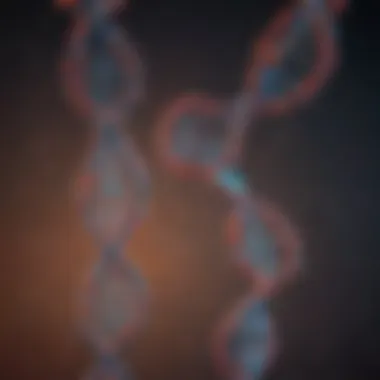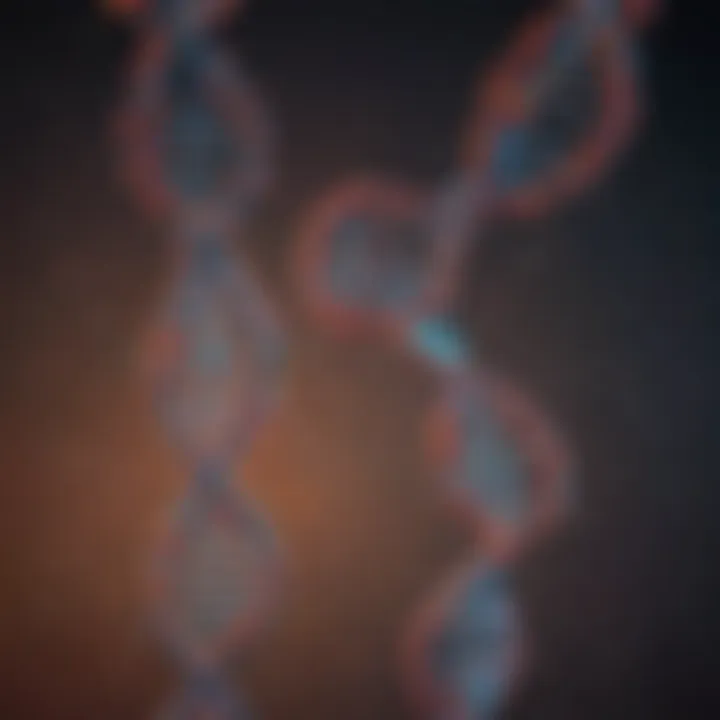HRR Gene Mutation: Mechanisms and Impacts on Health


Intro
Understanding the role of genes in health and disease is an ongoing challenge in modern science. Among these genes, the HRR (Homologous Recombination Repair) gene holds significant importance. It is a central player in maintaining genomic stability, which is vital for normal cellular function. When mutations occur in the HRR gene, they can lead to various diseases, particularly cancers. The implications of these mutations extend beyond individual health, influencing genetic research, diagnosis, and treatment strategies. This article aims to delve into the complex interplay of HRR gene mutations, shedding light on their mechanisms and potential therapeutic paths.
Background and Context
Overview of the Research Topic
HRR genes are crucial for repairing DNA double-strand breaks, a type of damage that can lead to severe cellular errors if not corrected. Many HRR genes, including BRCA1 and BRCA2, characterize distinct pathways necessary for proper DNA repair. A mutation in these genes disrupts this process, escalating the risk for various cancers, most notably breast and ovarian cancers. The study of HRR gene mutations has gained traction, offering insights that contribute to understanding genetic predisposition to disease and crafting personalized medicine strategies.
Historical Significance
The exploration of HRR genes began in earnest in the late 20th century when researchers first noticed an association between mutations in these genes and increased cancer risk. Since then, significant advances have been made in genetic testing and analysis, leading to a better understanding of inherited cancer syndromes. The identification of BRCA1 and BRCA2 as critical HRR genes revolutionized the field. Attentions shifted towards developing targeted therapies, such as PARP inhibitors, which exploit the weaknesses in cancer cells with HRR deficiencies. This historical context lays the groundwork for appreciating current advances and ongoing research in the field.
Key Findings and Discussion
Major Results of the Study
Recent studies have significantly advanced our understanding of HRR gene mutations.
- Increased Cancer Risk: Individuals with HRR mutations are at a higher risk for several cancers.
- Therapeutic Targets: Identifying these mutations has led to targeted treatment options for patients, primarily those involving PARP inhibitors.
- Genetic Counseling: There is a growing emphasis on the role of genetic counseling for at-risk individuals, which can help them make informed decisions about their health.
Detailed Analysis of Findings
The detailed analysis of various studies reveals that HRR gene mutations impact not only individual prognosis but also treatment strategies. For instance, mutations in BRCA genes can predict responsiveness to certain therapies, guiding oncologists in decision-making processes. Moreover, the relevance of HRR genes has expanded into fields beyond oncology, influencing research in reproductive health and aging.
Understanding the mechanisms behind HRR gene mutations fosters the emergence of precision medicine. Personalized approaches increasingly rely on genomic insights to tailor treatments that enhance efficacy and minimize toxicities.
Implementing findings from HRR gene mutation research represents a quintessential evolution of medicine towards customization, adapting treatment to the individual rather than a one-size-fits-all approach.
Understanding HRR Gene Functionality
Understanding HRR gene functionality is critical in exploring how mutations in these genes influence individual health and disease processes. HRR genes are essential for maintaining genomic stability. Their proper function directly correlates with the body's ability to repair DNA. Given that DNA damage occurs continuously due to natural biological processes and environmental factors, effective repair mechanisms are necessary. When HRR gene functionality is compromised, it can lead to serious implications such as increased susceptibility to various cancers. Thus, a thorough examination of HRR genes helps illuminate pathways and potential interventions in health management, particularly in personalized medicine.
Overview of HRR Genes
HRR genes, or Homologous Recombination Repair genes, form a crucial part of the cellular machinery responsible for repairing double-strand DNA breaks. Some of the most notable HRR genes include BRCA1, BRCA2, and RAD51. These genes provide instructions for making proteins involved in the repair process. Mutations in these genes can lead to impaired DNA repair capabilities, affecting cellular health and stability.
The role of HRR genes extends beyond simply contributing to repair functions. They help preserve the integrity of the genetic material across generations of cells. Any aberration in their function can precipitate a cascade of genetic errors, leading to disease.
Role of HRR Genes in DNA Repair
HRR genes play a pivotal role in the cellular response to DNA damage. When a double-strand break occurs, the repair process involves the use of the homologous chromosome as a template. This process is not only accurate but also efficient, allowing cells to restore their DNA back to its original state with minimal errors. The functionality of HRR genes directly impacts the precision of this repair process.
As various cells in the body experience DNA damage, the reliance on functional HRR genes is paramount. Deficiencies in these genes can lead to genomic instability and contribute to oncogenesis. Therefore, understanding the role of HRR genes in DNA repair informs both the mechanisms of cancer development and potential strategies for intervention.
Mechanisms of Action
Homologous Recombination
Homologous recombination is a key aspect of HRR gene functionality. This mechanism allows for the accurate repair of double-strand breaks by utilizing a homologous sequence as a template. One of the primary characteristics of homologous recombination is its ability to ensure high fidelity in DNA repair, thereby preventing mutations.
The unique feature of homologous recombination is its reliance on the intact homologous chromosome. This dependency is advantageous due to the precision it offers; however, it also presents challenges. In the absence of a homologous template, cells may resort to error-prone repair methods, leading to genomic chaos.
Repair Pathway Coordination
Repair pathway coordination is essential in managing how the HRR pathway operates alongside other repair mechanisms. It ensures that the cell can choose the most appropriate and efficient pathway for repair based on the type of DNA damage encountered.
A key characteristic of this coordination is the ability to switch between different repair pathways, such as non-homologous end joining when homologous recombination is not feasible. This adaptability is beneficial, but it raises complexities in understanding how cells decide which pathway to utilize. The inefficiencies in repair coordination may lead to an increased likelihood of mutations, impacting cancer progression.
"Understanding HRR gene functionality provides insights into how our bodies manage DNA damage and how these processes can go awry in cancer."


This section showcases the critical nature of HRR genes, the intricate processes involved in their mechanisms, and their implications for genomic health. The continued exploration of HRR gene functionality will be crucial as we further understand the complexities of genetic mutations and their clinical relevance.
Types of HRR Gene Mutations
In understanding the role of HRR gene mutations, it is important to classify the types that can occur. Each mutation can potentially alter gene function and ultimately disrupt DNA repair processes. This section explores the three main types: point mutations, insertions and deletions, and copy number variations. Recognizing these distinctions helps clarify their individual and collective relevance in health and disease.
Point Mutations
Point mutations refer to changes in a single nucleotide base pair in the DNA sequence. These mutations can be categorized into missense, nonsense, and silent mutations.
- Missense mutations result in a different amino acid being incorporated into the protein. This alteration can affect protein function significantly.
- Nonsense mutations create a premature stop codon, leading to a truncated protein, which often lacks normal functionality.
- Silent mutations do not lead to changes in the amino acid sequence but may still influence the gene's regulation or expression.
The implications of point mutations in HRR genes, such as the BRCA1 and BRCA2 genes in breast cancer, illustrate how a small change in the genetic code can have profound consequences on an individual’s cancer risk.
Insertions and Deletions
Insertions and deletions (often abbreviated as indels) modify the DNA sequence by adding or removing one or more nucleotides. This type of mutation can result in a shift in the reading frame of the gene, leading to extensive changes in the protein's amino acid sequence.
- Insertions can introduce extra amino acids into a protein, which might cause dysfunction.
- Deletions may remove crucial parts of the protein, ultimately affecting its structural integrity.
Fundamentally, indels can disrupt the normal functioning of HRR pathways and contribute to genomic instability, which is a hallmark of cancer cells. The understandings of these mutations help in tailoring treatment strategies based on their occurrence.
Copy Number Variations
Copy number variations (CNVs) are a more complex type of mutation, involving the duplication or deletion of large segments of DNA. These variations can affect entire genes or regulatory regions, leading to increased or decreased expression.
CNVs have been associated with various cancers, highlighting their significance in the study of HRR gene mutations. Their impact on gene dosage can modify the response to chemotherapy. Understanding these variations provides insight into cancer predisposition and prognosis.
"Copy number variations play a pivotal role in understanding the genetic basis of individual responses to cancer therapy."
Closure
In summary, the types of HRR gene mutations range from point mutations affecting single nucleotides to complex copy number variations impacting larger DNA segments. Each type carries specific implications for cellular processes and disease states, underscoring the necessity of precise genetic analysis in clinical settings.
Clinical Significance of HRR Gene Mutations
The understanding of HRR gene mutations is critical in the realm of medicine, especially in oncology. These mutations lead to substantial disruptions in DNA repair mechanisms, which can escalate genomic instability and fuel the development and progression of various cancers. By comprehending the implications of HRR gene mutations, healthcare providers can devise more effective diagnostic tools, screening processes, and therapeutic strategies aimed at improving patient outcomes.
Oncology Implications
Breast Cancer
Breast cancer serves as a prominent example of the clinical significance of HRR gene mutations. Mutations in genes like BRCA1 and BRCA2 are well-known contributors to hereditary breast cancer. Studies have shown that these mutations can lead to a substantially increased lifetime risk of developing breast cancer. Their unique feature lies in the gene's role in homologous recombination repair, which is vital for fixing double-strand DNA breaks.
The benefits of focusing on breast cancer in this context are extensive. For one, understanding the HRR mutations helps in identifying individuals with higher risk, enabling preventative measures such as the consideration of prophylactic surgeries or intensified screening protocols. Furthermore, this insight can also inform targeted therapy approaches, such as PARP inhibitors, which exploit the DNA repair weaknesses in these tumors.
Ovarian Cancer
Ovarian cancer is another critical area influenced by HRR gene mutations, particularly BRCA mutations. These mutations lead to significant implications in the disease's progression and management. Women carrying these mutations are at increased risk not only for ovarian cancer but also for breast cancer, amplifying the importance of research in this domain.
A key characteristic of ovarian cancer related to HRR mutations is the tumor's increased sensitivity to platinum-based chemotherapy. This aspect is beneficial for patients, as it provides alternative treatment options when standard measures fail. However, this sensitivity also has a downside, as some tumors may develop resistance over time, complicating the management of recurrent disease.
Impact on Cancer Treatment
Targeted Therapies
Targeted therapies represent a significant advancement in the treatment of cancers associated with HRR mutations. One notable example is the use of PARP inhibitors, which specifically target tumors with defective HRR mechanisms. These therapies are designed to hinder cancer cell survival by exploiting the inherent weaknesses that arise from HRR gene defects.
The appeal of targeted therapies is clear; they often result in less toxicity compared to traditional chemotherapy. However, their success depends on accurate identification of patients with HRR mutations, underscoring the need for comprehensive genetic testing procedures.
Chemotherapy Resistance
Chemotherapy resistance is a persistent challenge in the treatment of cancers with HRR gene mutations. Some tumors exhibit resilience against standard treatment methods, leading to treatment failure and patient relapse. This resistance is a critical concern, as it can lead to poorer prognosis and necessitate alternative therapeutic approaches.


Understanding the mechanisms behind chemotherapy resistance is essential in developing strategies to overcome it. Research indicates that a better grasp of tumor biology, coupled with innovative therapeutic combinations, may enhance treatment efficacy.
Diagnosis and Screening
Accurate diagnosis and screening are paramount in managing HRR gene mutations and their associated cancers. Genetic tests that identify HRR mutations can lead to earlier detection of breast and ovarian cancers, which is essential for improving survival rates. Moreover, screening measures, such as MRI and mammography, have become standard practice in monitoring high-risk individuals.
"Early identification and intervention can significantly change the course of treatment and improve patient outcomes."
Mechanisms of HRR Gene Mutations in Pathophysiology
Understanding the mechanisms of HRR gene mutations is vital for comprehending their role in various diseases and biological processes. These mutations can lead to significant disruptions in cellular functionality, particularly in the context of cancer and other genetic disorders. By exploring DNA repair pathways and their implications, we can better grasp how HRR gene mutations contribute to disease progression and therapeutic challenges.
Genomic Instability
Genomic instability is a key concept in cancer biology. HRR genes play a pivotal role in maintaining genomic stability by facilitating accurate DNA repair. When HRR genes are mutated, the efficiency of DNA repair mechanisms diminishes. This dysfunction often results in an accumulation of mutations throughout the genome.
The continuous cycle of DNA damage and repair aggravates the risk of developing tumors, particularly in tissues with high turnover rates like breast and ovarian tissues. Researchers have observed that patients with mutations in specific HRR genes, like BRCA1 and BRCA2, exhibit a higher incidence of cancers. The flawed repair mechanisms may lead to chromosomal aberrations, which are common hallmarks of cancerous cells. In addition, genomic instability can enhance tumor heterogeneity, making treatment more complicated.
Influence on Tumor Microenvironment
The tumor microenvironment significantly influences cancer development and treatment responses. HRR gene mutations can alter the composition and activity of the tumor microenvironment. For instance, increases in genomic instability can cause the release of signaling molecules that attract immune cells, creating an inflammatory environment. This inflammatory state may benefit tumor progression, as cancer cells can evade immune detection or even exploit immune responses for growth.
Moreover, mutations can lead to the formation of tumor-associated fibroblasts, which are crucial in modifying the extracellular matrix. This alteration can influence tumor architecture, nutrient availability, and metastatic potential. Research highlights that a disrupted microenvironment can further impair treatment efficacy by promoting chemotherapy resistance. In this context, targeting both the tumor cells and the surrounding environment could yield more effective strategies for managing HRR-related cancers.
The interplay between HRR gene mutations and the tumor microenvironment underscores the complexity of cancer biology and the necessity for integrative therapeutic approaches.
In summary, the mechanisms by which HRR gene mutations affect pathophysiology are multifaceted and critical in shaping disease outcomes. By examining genomic instability and its impact on the tumor microenvironment, we gain valuable insights into cancer mechanisms that may guide future research and therapeutic advances.
Current Research and Advances
Current research on HRR gene mutations sheds light on their implications for both genetic understanding and clinical applications. The exploration of HRR mutations has seen significant growth, driven by the need to understand how these mutations affect various pathologies, especially cancers. This area of study is deeply intertwined with advancements in technology, genomic analysis, and emerging treatment options. Understanding recent discoveries and innovative methodologies is crucial for researchers and clinicians who are aiming to harness the power of HRR gene insights for better patient outcomes.
Recent Discoveries
New findings have added layers of complexity to our knowledge of HRR gene mutations. Researchers have begun identifying novel HRR genes that were previously unrecognized, expanding the scope of potential genetic involvement in diseases. For instance, unexpected mutations in genes like BRCA1 and BRCA2 have been charted, which not only impacts repair mechanisms but also intersects with therapeutic resistance. Furthermore, studies have highlighted variations in gene mutations among different populations, suggesting that genetic diversity plays a role in cancer susceptibility and treatment response.
Technological Innovations in Study
Technological advancements have been pivotal in the study of HRR gene mutations. Key innovations such as CRISPR and next-generation sequencing have revolutionized our approach to genetic research, allowing for more precise investigation and manipulation of genetic sequences.
CRISPR Applications
CRISPR technology is particularly notable for its efficiency in genome editing. By employing a targeted approach, CRISPR can induce specific alterations in HRR genes, thereby elucidating their roles in DNA repair pathways. This precise modification capability makes CRISPR a favored tool for researching gene functions and their mutations. Additionally, CRISPR's versatility allows scientists to explore the consequences of HRR mutations in various cellular contexts in real time, offering insights into potential therapeutic targets and mechanisms.
Key Characteristics
One of CRISPR’s defining features is its ability to execute cuts at precise DNA locations. This is beneficial as it leads to minimal unintended changes in the genome, distinguishing it from older gene-editing methods.
Advantages and Disadvantages
Though CRISPR presents many advantages, such as cost-effectiveness and high efficiency, it is not without challenges. Off-target effects, where unintended parts of the genome may be altered, can complicate interpretations of results. These risks necessitate careful validation of outcomes when using CRISPR in HRR gene studies.
Next-Generation Sequencing
Next-generation sequencing, or NGS, stands out for its ability to conduct comprehensive genomic analyses. This technology enables researchers to sequence billions of DNA strands simultaneously, facilitating an in-depth examination of HRR gene mutations across entire genomes. By providing a broader view of genetic variations, NGS is crucial for understanding how mutations affect DNA repair processes on a systemic scale.
Key Characteristics
NGS stands out for its throughput. It can handle large quantities of data in a relatively short time. This feature is particularly useful for studies aiming to correlate HRR mutations with clinical outcomes, enabling a faster transition from research to practical applications in medicine.
Advantages and Disadvantages


While NGS is a powerful tool that enhances data richness for HRR gene mutation studies, it also presents challenges. The need for significant data analysis expertise can be a barrier, especially in settings with limited resources. Moreover, interpreting the vast quantities of data generated requires a sophisticated understanding of both bioinformatics and genetics.
In summary, current research and advancements in HRR gene mutations promise to unveil critical insights into their roles in health and disease, fueled by cutting-edge technologies like CRISPR and next-generation sequencing. By fostering deeper understanding, these innovations pave the way for targeted therapies and personalized medicine.
Future Directions in HRR Gene Research
The exploration of HRR gene mutations is evolving rapidly, offering breakthroughs that could change our understanding of genetic conditions and their treatment. This section examines the future directions in HRR gene research, focusing on emerging technologies and their potential impact.
Gene Editing and Therapy Potential
Gene editing represents a revolutionary approach in genetic research, primarily aiming at correcting mutations in HRR genes. Techniques like CRISPR-Cas9 enable precise alterations to DNA, providing new avenues for targeting specific mutations that drive disease pathology.
Benefits of gene editing include:
- Precision: Targeted correction of mutations without off-target effects.
- Versatility: Applicable to various conditions linked to HRR gene mutations.
- Potential for cure: Moving from symptom management to actual correction of genetic anomalies.
Such advancements not only improve the understanding of HRR genes but also create hope for potential therapies. However, ethical considerations remain critical. The possibility of germline editing raises questions about long-term impacts on future generations and the need for regulations.
Integration of AI in Genetic Research
Artificial intelligence is poised to revolutionize the landscape of genetic research. By analyzing large datasets, AI facilitates the identification of patterns in HRR gene mutations and their implications for disease development.
Specific elements include:
- Data Analysis: Machine learning algorithms can process vast genomic data to uncover correlations between HRR mutations and particular diseases.
- Predictive Modeling: AI-driven models help forecast the likelihood of mutation-related disorders, improving screening processes.
- Drug Discovery: AI aids in identifying potential therapeutic compounds that target HRR-related pathways.
AI’s ability to handle complex datasets leads to more informed decisions in genetic research and enhances the efficiency of clinical studies.
As these technologies advance, HRR gene research will likely witness immense progress. Integration of AI tools will streamline workflows, enabling researchers to focus on interpretation rather than data collection.
In summary, focusing on gene editing capabilities and AI applications can significantly enhance our understanding of HRR gene mutations. These future directions promise to yield novel insights that could transition genetic research from theory into impactful real-world applications.
Ethical Considerations in HRR Gene Research
In the field of genetics, the study of HRR gene mutations opens up a range of ethical considerations that must be acknowledged. These issues are especially pertinent when it comes to genetic testing and therapy, as they intersect with individual rights, societal norms, and medical practices. The importance of addressing these ethical considerations cannot be overstated. It shapes how research is conducted, influences public perception, and ultimately affects patient care.
HRR gene research carries significant implications that extend beyond the scientific community. The knowledge gained from studying these mutations has the potential to affect how diseases are diagnosed and treated. However, this power also raises questions regarding consent, privacy, and the possible misuse of genetic data. These ethical dilemmas must be navigated with care to ensure that the benefits of HRR research are realized while respecting individuals' rights and autonomy.
Genetic Privacy Concerns
Genetic privacy is a primary concern within the realm of HRR gene research. As genetic data becomes more accessible for research and clinical applications, the risk of unauthorized access to personal information increases. Individuals may fear that their genetic data could be used against them in various ways, including discrimination in insurance coverage and employment opportunities.
Key aspects of genetic privacy concerns include:
- Informed Consent: Patients must understand how their genetic information will be used, stored, and shared. Proper informed consent processes must ensure they are fully aware of the implications of their participation in HRR research.
- Data Security: The increasing use of big data analytics in genetics raises questions about the security of personal genetic information. Robust security measures need to be implemented to prevent potential breaches.
- Anonymity and De-Identification: Researchers must ensure that genetic data is appropriately anonymized to protect individuals' identities. However, there remains a risk of re-identification, which complicates the ethical landscape further.
In recent years, there has been a growing push for policies that strengthen genetic privacy protections, balancing the needs of research with the rights of individuals. This issue will continue to evolve as technology advances.
Implications for Genetic Counseling
Genetic counseling plays a critical role in interpreting HRR gene mutations and their implications for individuals and families. Ethical considerations within this context focus on communication, decision-making, and emotional support. Counselors must navigate complex moral terrain while providing guidance based on scientific evidence.
Some of the important implications for genetic counseling include:
- Informed Decision-Making: Counselors must help patients make decisions that align with their values and beliefs, ensuring they understand the potential outcomes of genetic testing.
- Support Systems: The emotional impact of learning about genetic risks can be significant. Counselors must be prepared to assist individuals and families in coping with this information, fostering resilience and understanding.
- Advocacy for Patients: Genetic counselors can serve as advocates for patients, ensuring they have access to appropriate medical and psychological support based on their genetic background.
In these ways, genetic counseling bridges the gap between clinical information and individual needs, addressing ethical concerns associated with HRR gene mutations and their testing.
"As we explore the potential of HRR gene mutations, it is crucial that ethical considerations guide our research and clinical practices to foster trust and protect individual rights."
Addressing these ethical aspects is essential for developing responsible policies and practices that benefit individuals and society as a whole.
Ending
The conclusion of this article underscores the importance of understanding HRR gene mutations and their wide-ranging implications. These mutations are not just alterations in the genetic code; they play a pivotal role in the stability of the genome, affecting key biological processes such as DNA repair and cellular function. As discussed in the previous sections, HRR gene mutations contribute to various cancers and can significantly influence treatment options, paving the way for personalized medical approaches.
A key aspect of this topic is its relevance in advancing research, particularly in the realms of oncology and gene therapy. By grasping the mechanisms behind HRR gene mutations, researchers and healthcare professionals can better tailor treatment strategies to individual patients, which is essential in modern medicine. Additionally, the ethical considerations surrounding genetic research cannot be overlooked as they raise questions about privacy, informed consent, and the broader societal implications of genetic information.
In summary, HRR gene mutations represent a complex area of research that is critical to both the understanding of disease mechanisms and the development of effective therapeutic strategies. As this field continues to evolve, staying informed about the latest advancements and ethical considerations will empower students, researchers, and healthcare practitioners to make informed decisions and contribute to a more sophisticated dialogue surrounding genetic research and its applications.
Summary of Key Points
- HRR gene mutations are crucial to genome stability and DNA repair mechanisms.
- They have significant implications in various cancers, notably breast and ovarian.
- Understanding these mutations facilitates the development of personalized cancer therapies.
- Ethical considerations regarding genetic information emphasize the necessity of careful management and counseling in genetic research.
- Continuing research and technological advancements are fundamental in elaborating our understanding of HRR gene mutations and their potential therapeutic applications.







